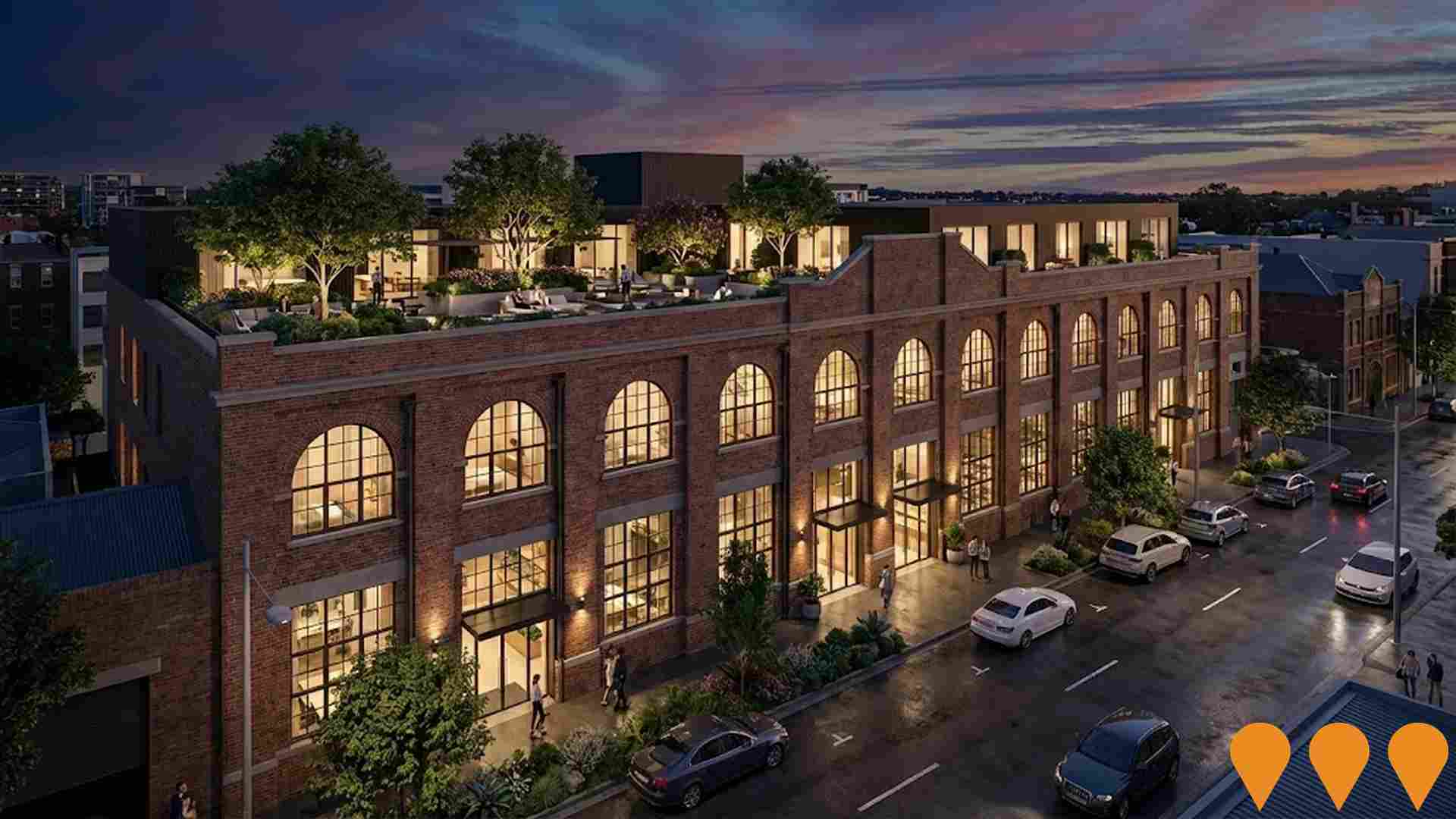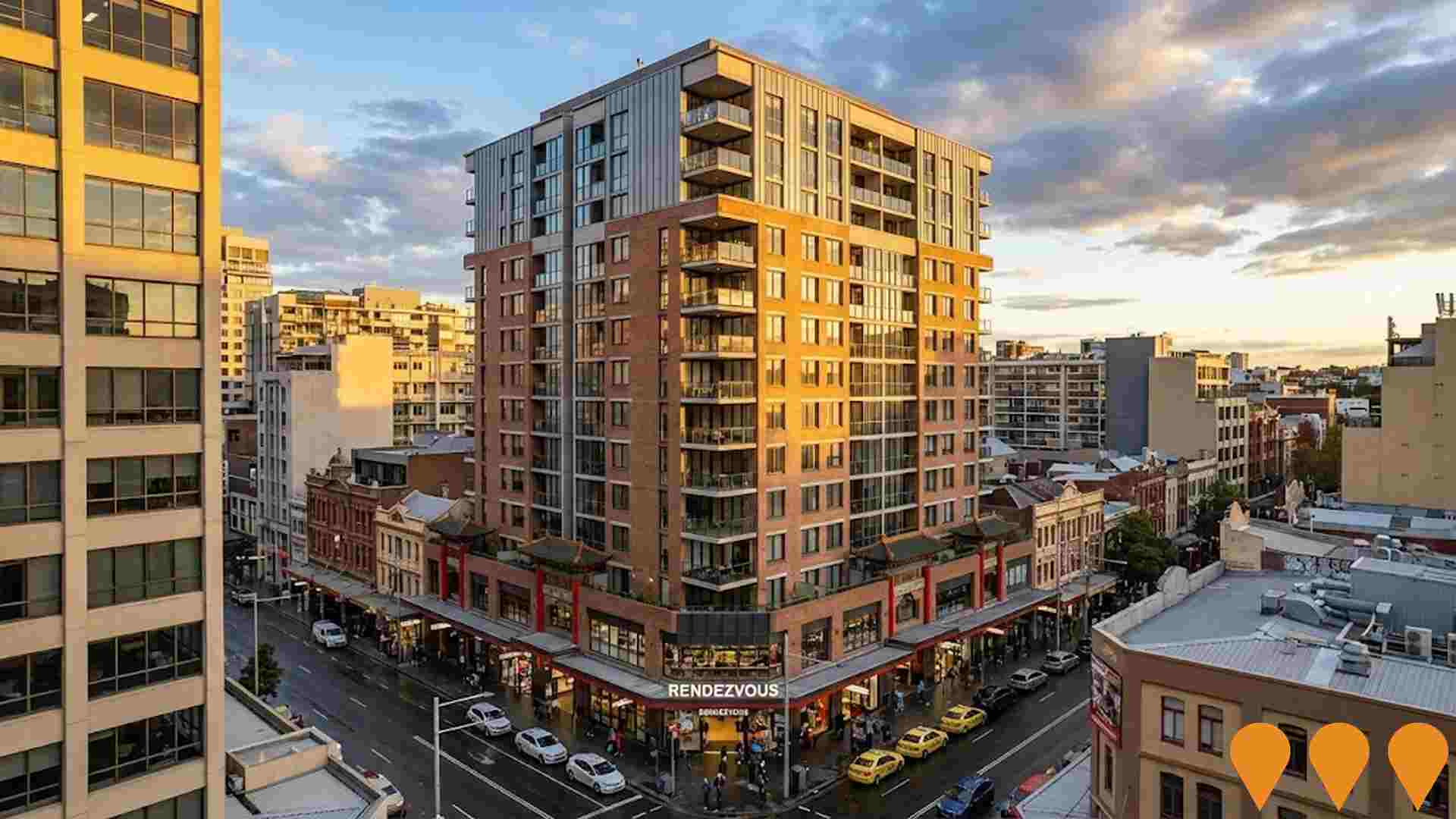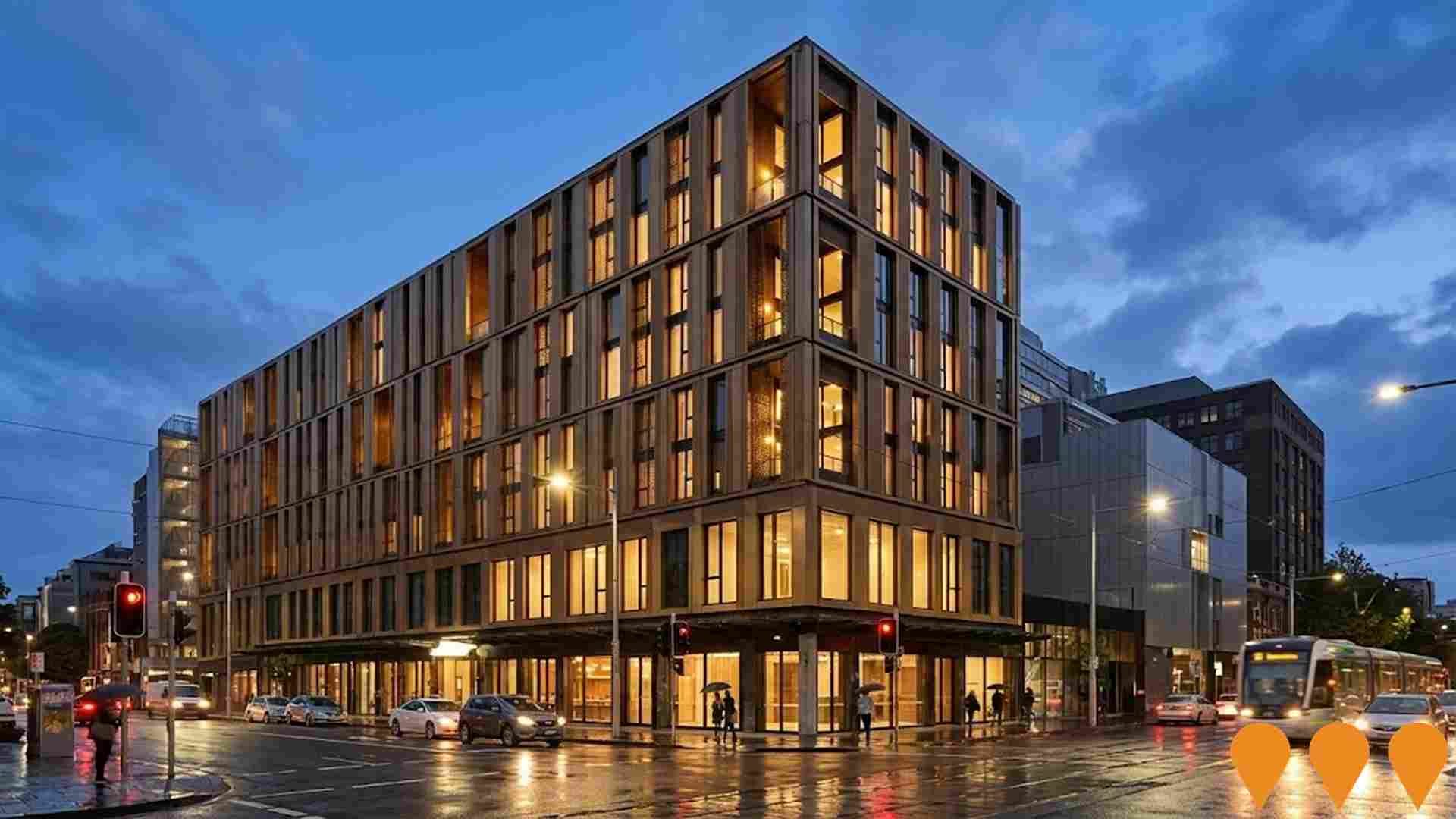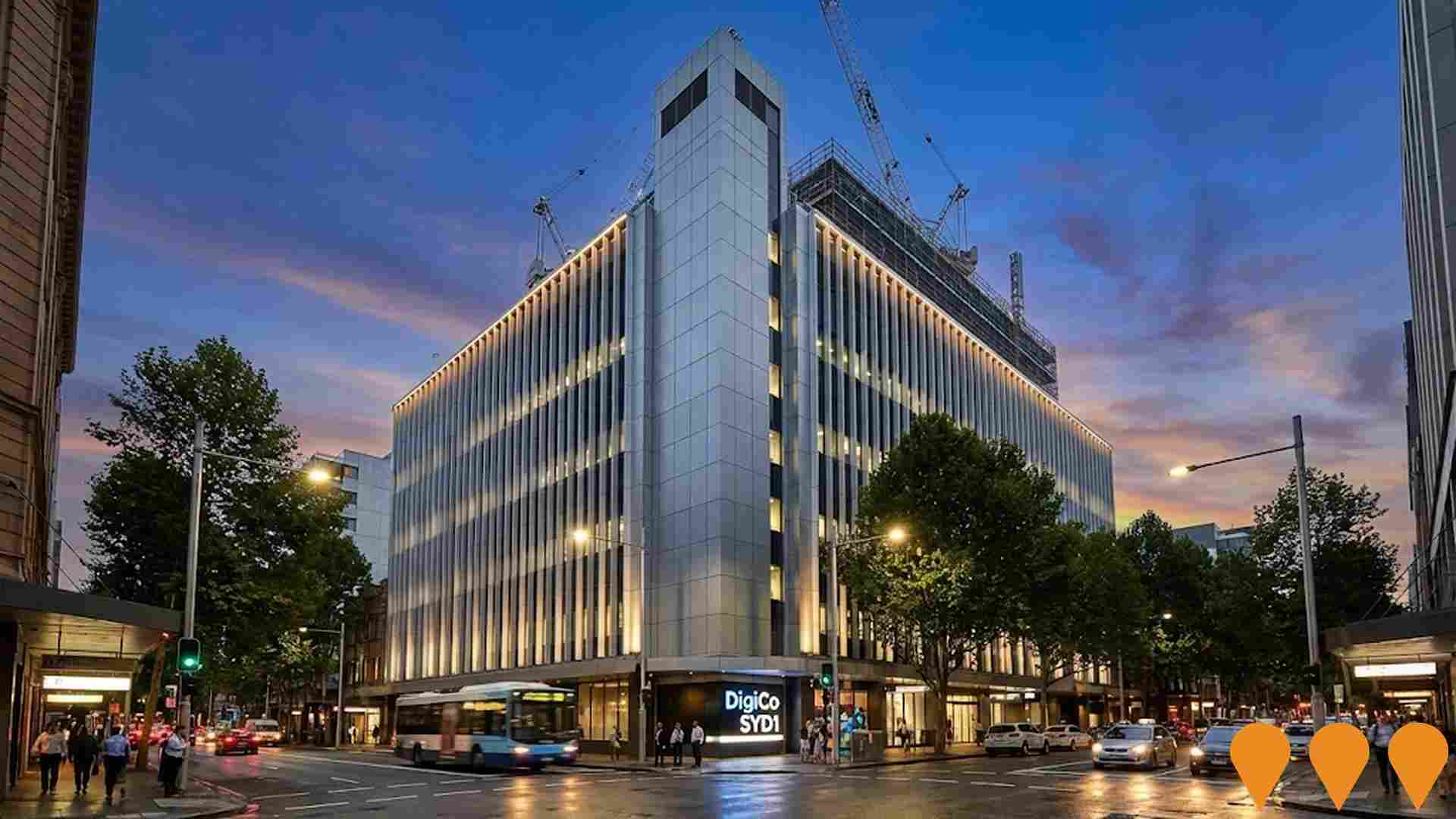Chart Color Schemes
est. as @ -- *
ABS ERP | -- people | --
2021 Census | -- people
Sales Activity
Curious about local property values? Filter the chart to assess the volume and appreciation (including resales) trends and regional comparisons, or scroll to the map below view this information at an individual property level.
Find a Recent Sale
Sales Detail
Population
An assessment of population growth drivers in Ultimo reveals an overall ranking slightly below national averages considering recent, and medium term trends
Ultimo's population is around 9,616 as of Nov 2025. This reflects an increase of 2,206 people since the 2021 Census, which reported a population of 7,410 people. The change is inferred from the estimated resident population of 10,044 from the ABS as of June 2024 and address validation since the Census date. Ultimo's population density ratio is 17,171 persons per square kilometer, placing it in the top 10% of national locations assessed by AreaSearch, indicating high demand for land in the area. The growth rate of 29.8% since the 2021 Census exceeds both the state's (6.7%) and metropolitan area's rates, positioning Ultimo as a growth leader. Overseas migration contributed approximately 96.7% of overall population gains recently.
AreaSearch adopts ABS/Geoscience Australia projections for each SA2 area, released in 2024 with 2022 as the base year. For areas not covered by this data, NSW State Government's SA2 level projections are used, released in 2022 with 2021 as the base year. Growth rates by age group from these aggregations are applied to all areas for years 2032 to 2041. Population projections indicate a significant increase in the top quartile of national areas by 2041, with Ultimo expected to grow by 3,534 persons, reflecting a total increase of 41.2% over the 17 years.
Frequently Asked Questions - Population
Development
Residential development activity is lower than average in Ultimo according to AreaSearch's national comparison of local real estate markets
Ultimo has seen few dwelling approvals in recent years. Between FY-21 and FY-25, 3 homes were approved, with another 1 approved so far in FY-26. This averages to approximately 377.3 new residents per year for each home built during this period.
The supply of dwellings is significantly lagging demand, which typically leads to heightened buyer competition and pricing pressures. New properties are constructed at an average expected cost of $491,000, indicating a focus on the premium segment with upmarket properties. In FY-26, $6.6 million in commercial development approvals have been recorded, suggesting Ultimo's residential character. Compared to Greater Sydney, Ultimo records lower building activity. This scarcity of new dwellings usually strengthens demand and prices for existing properties. However, building activity has accelerated in recent years, though it remains below the national average, indicating the area's established nature and potential planning limitations. All new construction in Ultimo between FY-21 and FY-25 comprised detached houses, sustaining the area's suburban identity with a concentration of family homes suited to buyers seeking space. This focus on detached housing is more pronounced than current patterns suggest (0.0% at Census), demonstrating ongoing robust demand for family homes despite increasing density pressures.
Frequently Asked Questions - Development
Infrastructure
Ultimo has very high levels of nearby infrastructure activity, ranking in the top 10% nationally
Changes to local infrastructure significantly influence an area's performance. AreaSearch has identified 17 projects likely to impact the area. Key projects include Powerhouse Ultimo Renewal, apt.Broadway, DigiCo SYD1 Data Centre Expansion (88MW D&O Project), and Bay St, Ultimo. The following list details those most relevant.
Professional plan users can use the search below to filter and access additional projects.
INFRASTRUCTURE SEARCH
 Denotes AI-based impression for illustrative purposes only, not to be taken as definitive under any circumstances. Please follow links and conduct other investigations from the project's source for actual imagery. Developers and project owners wishing us to use original imagery please Contact Us and we will do so.
Denotes AI-based impression for illustrative purposes only, not to be taken as definitive under any circumstances. Please follow links and conduct other investigations from the project's source for actual imagery. Developers and project owners wishing us to use original imagery please Contact Us and we will do so.
Frequently Asked Questions - Infrastructure
New Sydney Fish Market
The NSW Government is delivering a purpose-built new Sydney Fish Market at Blackwattle Bay designed by 3XN with BVN and Aspect Studios. The c. 26,000 sqm facility will house retail, restaurants and bars, fishmongers and wholesale auction facilities, new wharf and boating infrastructure, and a continuous public foreshore promenade. Construction is nearing completion with government indicating building completion and handover to the operator in late 2025, with public opening scheduled for 19 January 2026. The project is expected to attract over 6 million visitors annually.
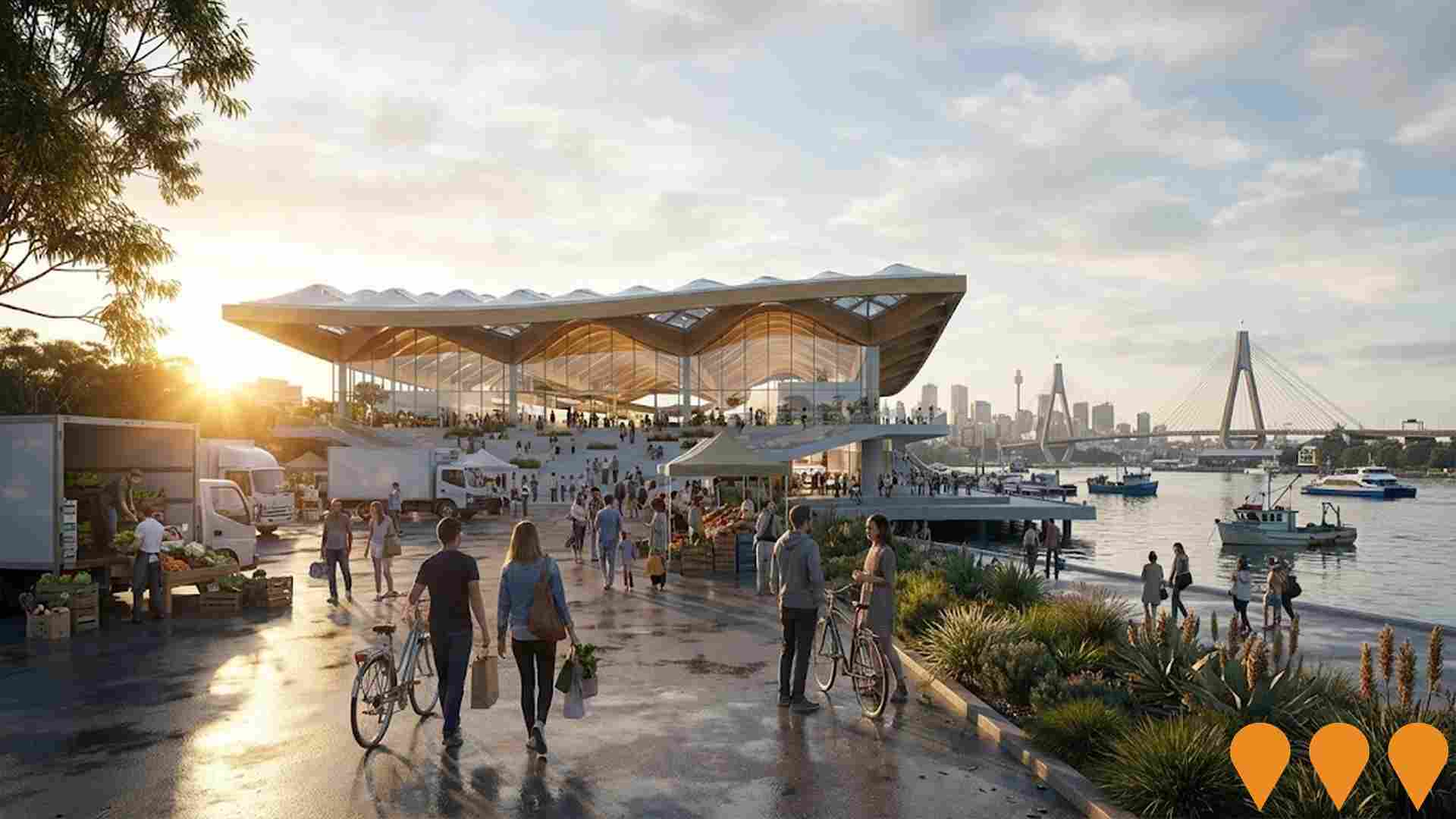
Tech Central Innovation Precinct
A 6ha+ innovation district spanning Central Station, South Eveleigh, Camperdown and Haymarket. Designed to be Australia's leading deep-tech and advanced manufacturing hub with over 250,000 sqm of new commercial floor space, 25,000+ new jobs and co-location of universities, startups, scale-ups and global tech firms. Multiple buildings already under construction or completed (e.g. Tech Central Scaleup Hub, Atlassian HQ, Quantum Terminal, UTS Central Stage 2).

Central Place Sydney
A $3 billion flagship commercial development at the heart of Sydney's 'Tech Central' precinct. The project features two sustainable office towers (35 and 37 storeys) and a low-rise 'connector' building, delivering over 130,000sqm of premium workspace. Designed by SOM and Fender Katsalidis, it aims for 100% renewable energy operations and includes AI-powered closed cavity facades, extensive public realm upgrades, and retail amenities. It will serve as a workplace for over 15,000 employees.
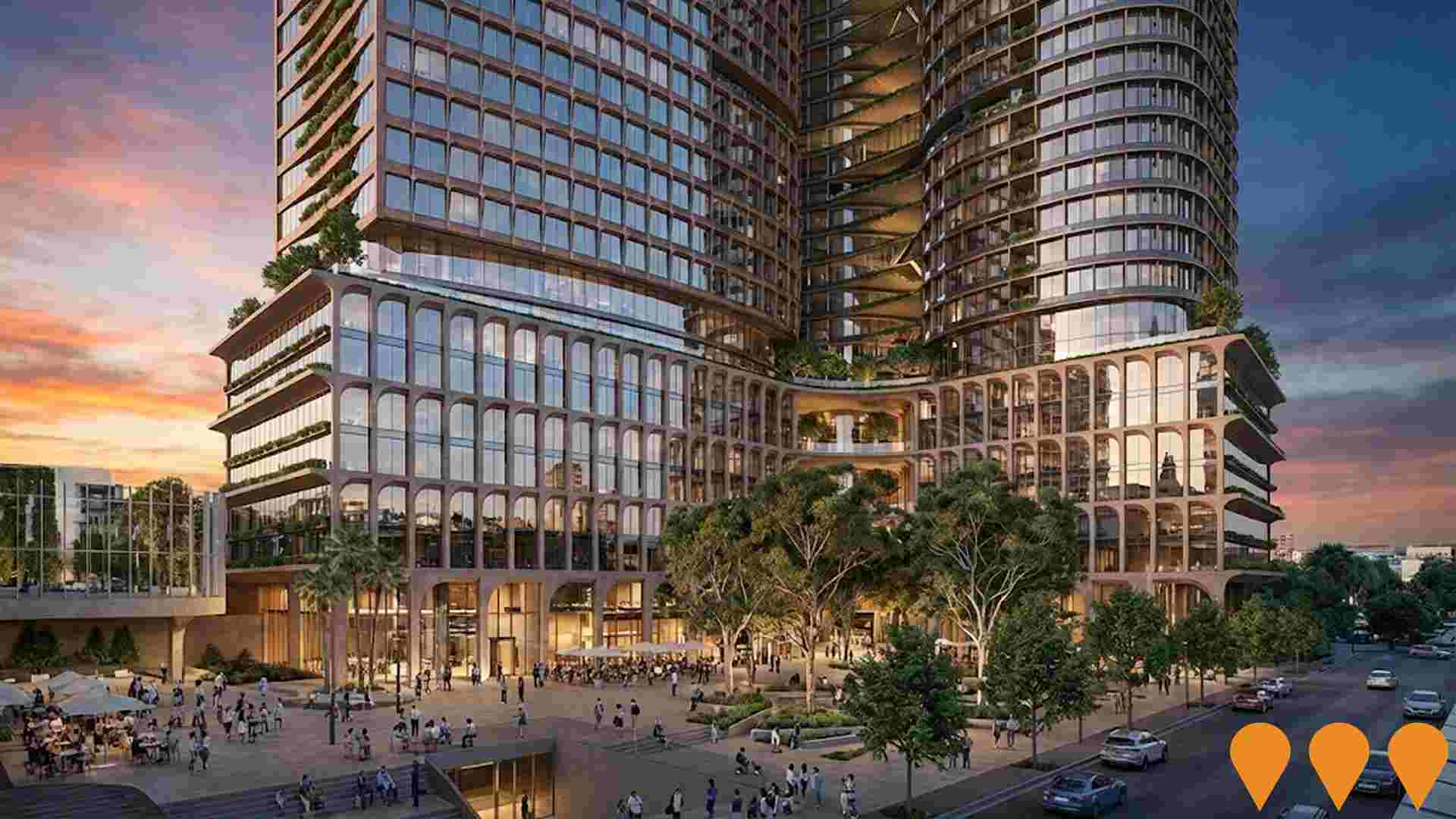
The Post House
45-storey mixed-use tower in the Tech Central precinct incorporating the heritage-listed former Parcels Post Office. Delivers 29,228sqm premium office space, 204-key hotel (levels 10-19), ground-floor and podium retail, co-working spaces, rooftop pool and day spa, and a new public plaza (Henry Deane Plaza). Construction is well underway with completion expected 2028.
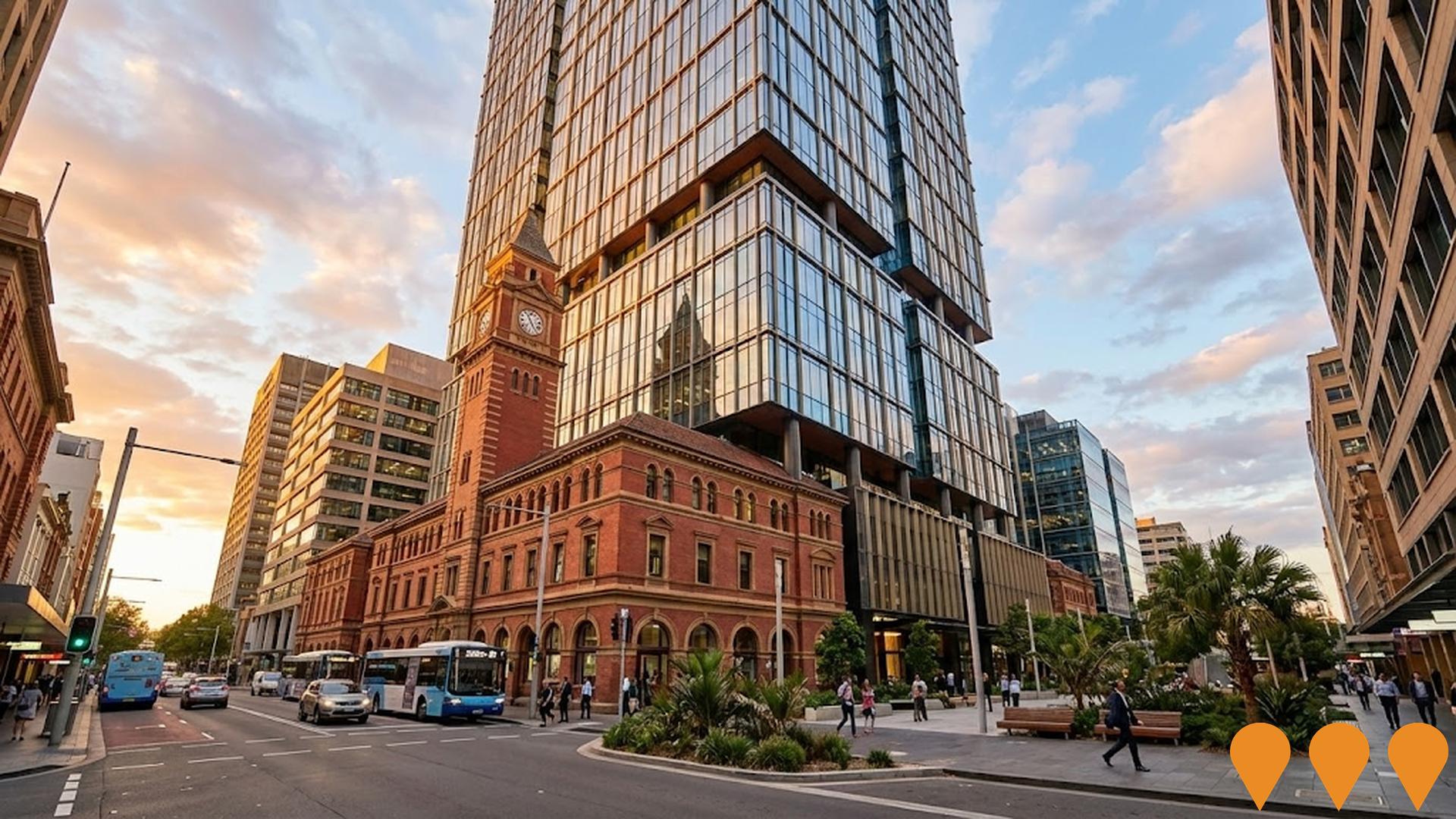
Powerhouse Ultimo Renewal
Major renewal and expansion of the Powerhouse Museum (Museum of Applied Arts and Sciences) in Ultimo. The project delivers new exhibition and education spaces, a 2,000 sqm public plaza on The Goods Line, rooftop venues, improved pedestrian links, heritage restoration of the Ultimo Powerhouse building, and adaptive reuse of the former Harwood building.
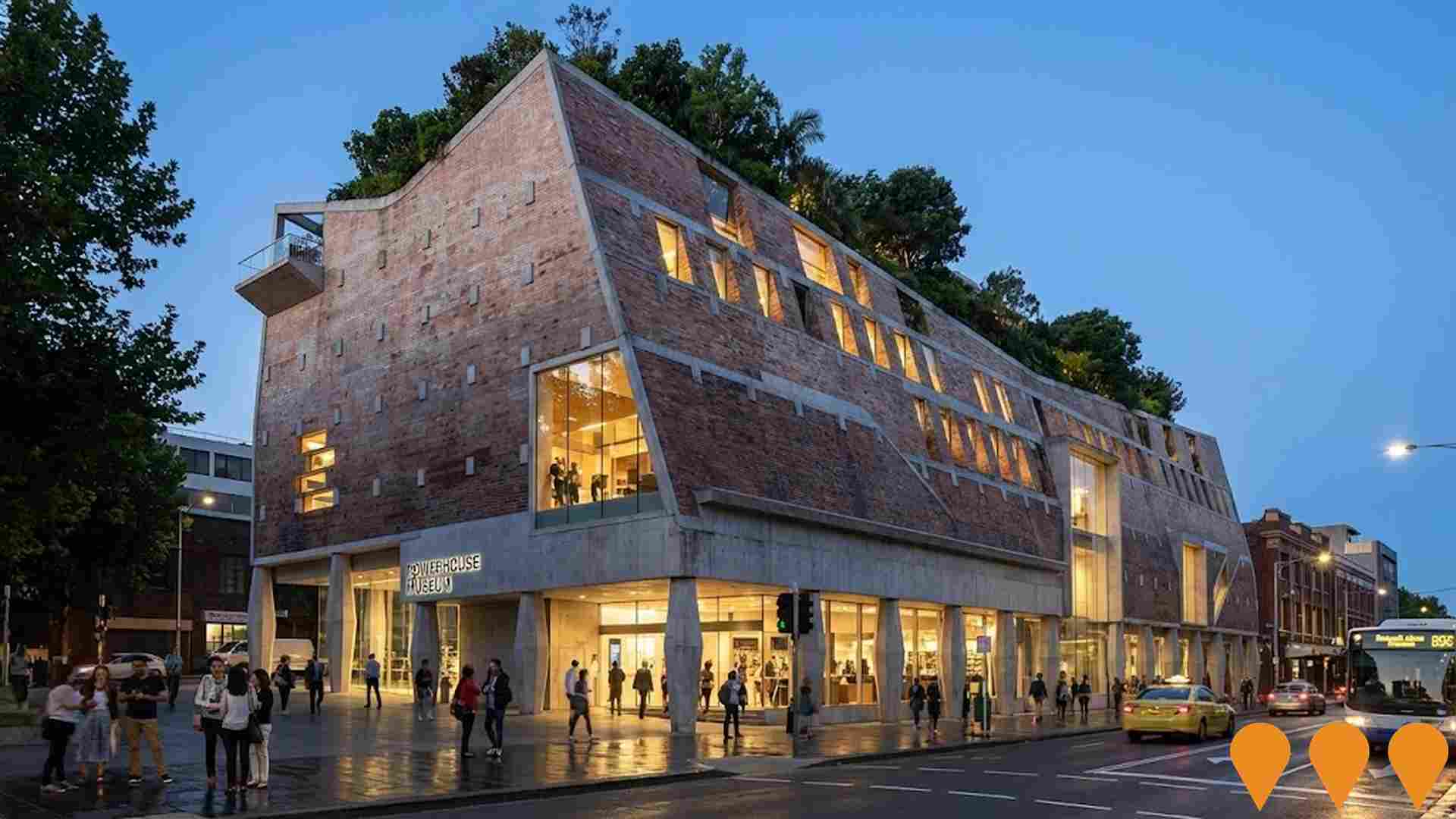
Mariyung Fleet (New Intercity Fleet)
The Mariyung Fleet is a 610-carriage double-deck electric train fleet being delivered by RailConnect NSW (UGL, Hyundai Rotem, Mitsubishi Electric Australia) for Transport for NSW. Named after the Darug word for emu, the fleet commenced passenger services on the Central Coast & Newcastle Line on 3 December 2024, followed by the Blue Mountains Line on 13 October 2025. Services on the South Coast Line are scheduled to commence in 2026. The fleet features modern amenities including spacious 2x2 seating, charging ports, improved accessibility with wheelchair spaces and accessible toilets, CCTV emergency help points, and dedicated spaces for luggage, prams and bicycles. The trains operate in flexible 4-car, 6-car, 8-car or 10-car formations. The fleet replaces aging V-set trains that entered service in the 1970s and serves approximately 26 million passenger journeys annually across the electrified intercity network. Supporting infrastructure includes the new Kangy Angy Maintenance Facility, platform extensions, and signaling upgrades at multiple stations.
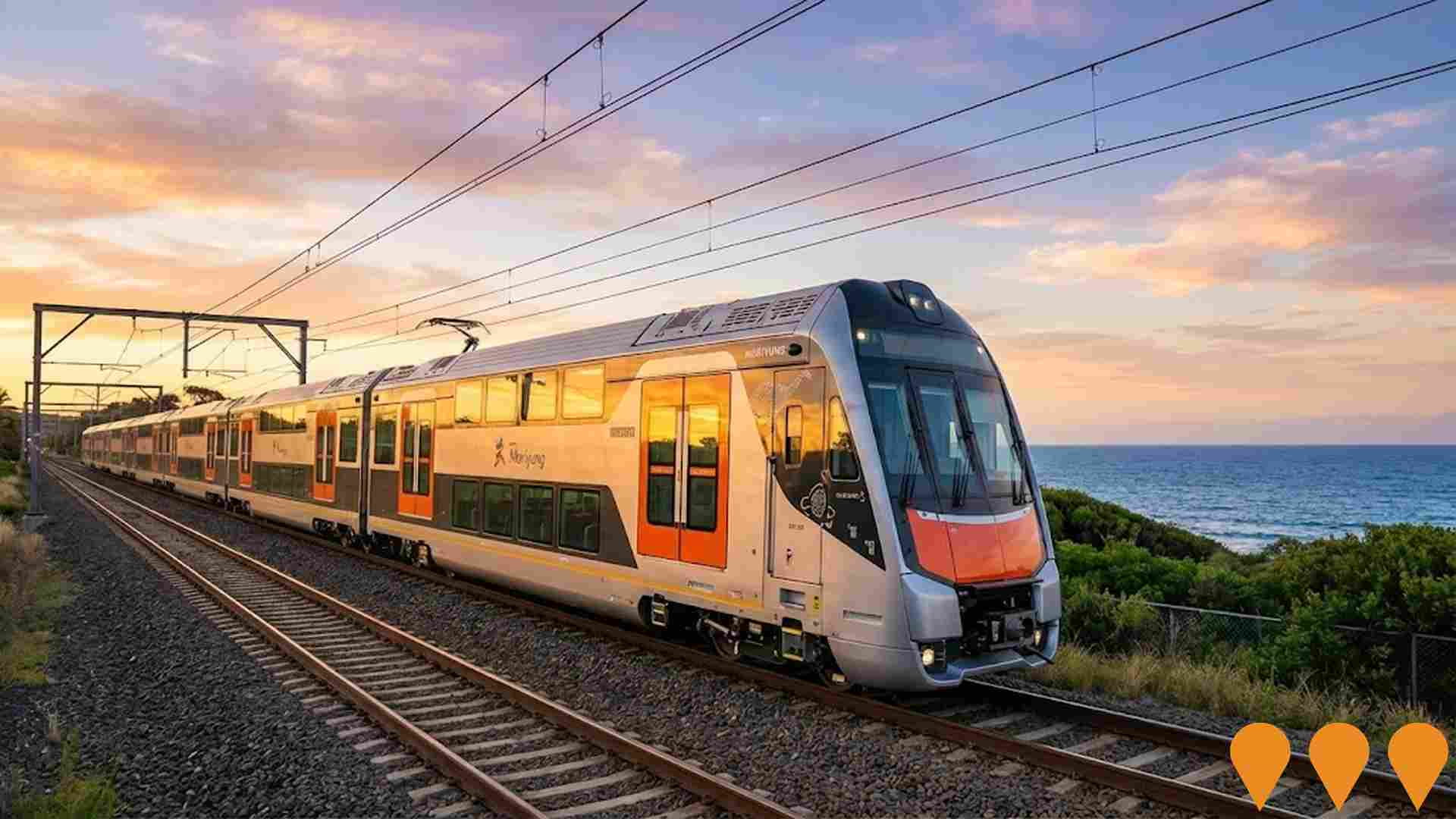
Harbourside Redevelopment by Mirvac
Mixed-use redevelopment of the former Harbourside Shopping Centre at Darling Harbour. Under a Mirvac and Mitsubishi Estate joint venture, the project delivers a 42-storey residential tower with about 263 apartments, around 33,500 sqm of office, 10,000 sqm of retail and hospitality, and 10,200 sqm of public domain including a widened waterfront promenade and proposed Waterfront Gardens. State Significant Development approvals include main works (Dec 2023) and public domain works (Jun 2025). Construction is underway with staged completion from late 2026.

Pyrmont Place
A $900 million mixed-use urban renewal development featuring 237 luxury apartments and penthouses across three residential towers, a commercial building, a 91-place childcare facility, a recreation centre with two indoor sports courts, and communal amenities like a pool, gym, and landscaped areas in the Pyrmont Peninsula. The project has received Stage 2 DA approval from the City of Sydney Council. Construction is expected to commence in mid-2025 with completion anticipated in early 2028.
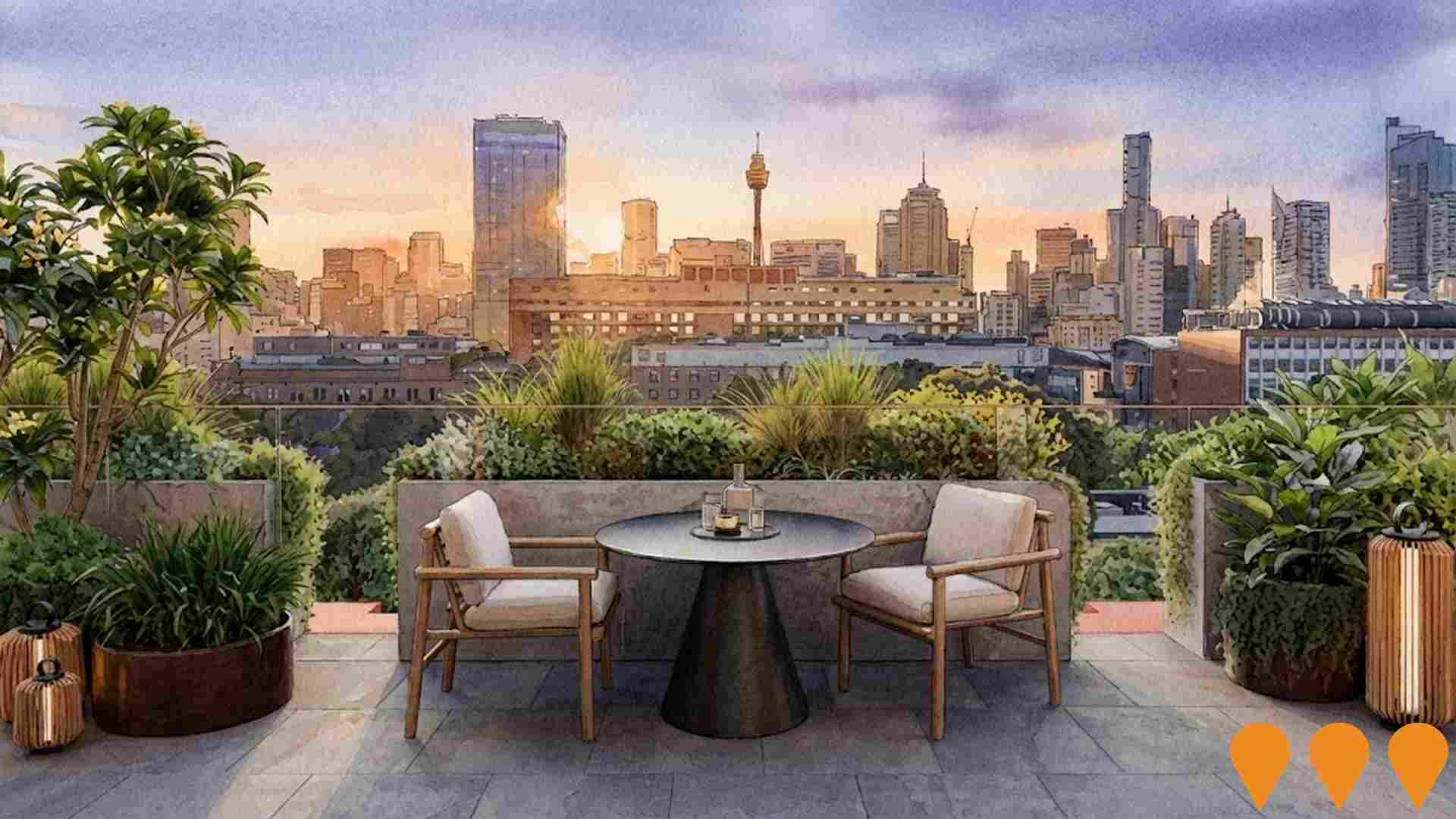
Employment
Employment performance in Ultimo exceeds national averages across key labour market indicators
Ultimo has a highly educated workforce with notable representation in the technology sector. Its unemployment rate was 3.1% as of June 2025, lower than Greater Sydney's 4.2%.
Employment growth over the past year was estimated at 1.0%. As of June 2025, 5,982 residents were employed with a workforce participation rate of 63.3%, slightly higher than Greater Sydney's 60.0%. Key industries for employment among residents are professional & technical services, accommodation & food, and education & training. Ultimo has a particular specialization in accommodation & food, employing 2.6 times the regional level.
Conversely, health care & social assistance employs only 8.3% of local workers, below Greater Sydney's 14.1%. The area functions as an employment hub with 2.0 workers per resident, hosting more jobs than residents and attracting workers from surrounding areas. Between June 2024 and June 2025, employment levels increased by 1.0% while the labour force grew by 0.6%, leading to a unemployment rate decrease of 0.3 percentage points. In contrast, Greater Sydney experienced employment growth of 2.6% and labour force growth of 2.9%, with an unemployment rate increase of 0.3 percentage points. National employment forecasts from Jobs and Skills Australia, released in May 2025, project national employment expansion by 6.6% over five years and 13.7% over ten years. Applying these projections to Ultimo's employment mix suggests local growth of approximately 6.8% over five years and 13.7% over ten years.
Frequently Asked Questions - Employment
Income
Income levels sit below national averages according to AreaSearch assessment
AreaSearch's latest postcode level ATO data for financial year 2022 shows Ultimo's median income among taxpayers was $41,108 with an average of $61,333. This is below the national average. Greater Sydney's median income was $56,994 and average was $80,856 during the same period. Based on Wage Price Index growth of 12.61% since financial year 2022, current estimates for Ultimo would be approximately $46,292 (median) and $69,067 (average) as of September 2025. Census data indicates household, family and personal incomes in Ultimo rank modestly, between the 43rd and 53rd percentiles. Income distribution shows that 32.7% of locals (3,144 people) fall into the $1,500 - $2,999 category, reflecting regional patterns where 30.9% occupy this range. Housing affordability pressures are severe in Ultimo, with only 75.4% of income remaining, ranking at the 43rd percentile. The area's SEIFA income ranking places it in the 7th decile.
Frequently Asked Questions - Income
Housing
Ultimo features a more urban dwelling mix with significant apartment living, with a higher proportion of rental properties than the broader region
Dwelling structure in Ultimo, as per the latest Census, comprised 0.2% houses and 99.8% other dwellings. In comparison, Sydney metro had 2.3% houses and 97.7% other dwellings. Home ownership in Ultimo was at 13.2%, with mortgaged dwellings at 13.4% and rented dwellings at 73.4%. The median monthly mortgage repayment in Ultimo was $2,500, below Sydney metro's average of $2,705. The median weekly rent figure in Ultimo was $500, compared to Sydney metro's $550. Nationally, Ultimo's median monthly mortgage repayments were higher at $2,500 than the Australian average of $1,863, and rents were substantially above the national figure of $375.
Frequently Asked Questions - Housing
Household Composition
Ultimo features high concentrations of group households and lone person households, with a higher-than-average median household size
Family households constitute 45.4% of all households, including 10.5% couples with children, 27.1% couples without children, and 5.1% single parent families. Non-family households account for the remaining 54.6%, with lone person households at 36.6% and group households comprising 18.1%. The median household size is 2.1 people, larger than the Greater Sydney average of 1.9.
Frequently Asked Questions - Households
Local Schools & Education
Ultimo demonstrates exceptional educational outcomes, ranking among the top 5% of areas nationally based on AreaSearch's comprehensive analysis of qualification and performance metrics
Educational attainment in Ultimo is notably higher than broader benchmarks. Among residents aged 15+, 57.2% hold university qualifications, compared to 30.4% nationally and 32.2% in NSW. Bachelor degrees are the most common at 36.1%, followed by postgraduate qualifications (18.9%) and graduate diplomas (2.2%). Vocational pathways account for 19.6% of qualifications, with advanced diplomas at 12.0% and certificates at 7.6%.
Educational participation is high, with 45.6% of residents currently enrolled in formal education. This includes 24.0% in tertiary education, 2.7% in primary education, and 1.6% pursuing secondary education. Ultimo's three schools have a combined enrollment of 1,790 students as of the latest data. The area has significant socio-educational advantages with an ICSEA score of 1138. Educational institutions include one primary, one secondary, and one K-12 school. Ultimo functions as an education hub with 17.9 school places per 100 residents, significantly above the regional average of 7.7, attracting students from surrounding communities.
Frequently Asked Questions - Education
Schools Detail
Nearby Services & Amenities
Transport
Transport servicing is high compared to other areas nationally based on assessment of service frequency, route connectivity and accessibility
Transport analysis shows 13 active stops operating in Ultimo, offering mixed bus services. These stops are covered by 34 routes, facilitating 9,446 weekly passenger trips. Transport access is rated excellent, with residents typically placed 136 meters from the nearest stop.
Service frequency averages 1,349 daily trips across all routes, translating to about 726 weekly trips per individual stop.
Frequently Asked Questions - Transport
Transport Stops Detail
Health
Ultimo's residents boast exceedingly positive health performance metrics with very low prevalence of common health conditions across all age groups
Health outcomes data shows exceptional results across Ultimo, with very low prevalence of common health conditions across all age groups. The rate of private health cover is relatively low at approximately 51% of the total population (~4,865 people), compared to 69.7% across Greater Sydney.
Mental health issues and asthma are the most common medical conditions in Ultimo, impacting 5.8 and 4.8% of residents respectively. 85.5% of residents declare themselves completely clear of medical ailments, compared to 77.4% across Greater Sydney. As of 2016, 4.9% of Ultimo's residents are aged 65 and over (472 people), which is lower than the 9.7% in Greater Sydney. Health outcomes among seniors in Ultimo are particularly strong, broadly aligned with the general population's health profile.
Frequently Asked Questions - Health
Cultural Diversity
Ultimo is among the most culturally diverse areas in the country based on AreaSearch assessment of a range of language and cultural background related metrics
Ultimo has one of the highest linguistic diversities in Australia, with 62.7% of its residents speaking a language other than English at home. Born overseas make up 71.2% of Ultimo's population. Christianity is the predominant religion, practiced by 22.2%.
Buddhism, however, is more prevalent here than in Greater Sydney, comprising 13.9%, compared to the regional average of 7.1%. In terms of ancestry, Chinese residents make up 27.7% of Ultimo's population, significantly higher than the regional average of 13.0%. The 'Other' category comprises 24.2%, also notably higher than the region's 16.1%. English ancestry is less common in Ultimo at 11.9%, compared to the regional average of 19.8%. Certain ethnic groups show notable variations: Spanish residents make up 1.1% of Ultimo, slightly higher than the regional average of 1.0%. Korean residents comprise 1.7%, higher than the region's 1.1%. Russian ancestry is less common at 0.6%, compared to the regional average of 0.8%.
Frequently Asked Questions - Diversity
Age
Ultimo hosts a very young demographic, ranking in the bottom 10% of areas nationwide
Ultimo's median age is 28, lower than Greater Sydney's 37 and Australia's 38. Notably, those aged 25-34 make up 36.6% of Ultimo's population, compared to Greater Sydney's 19.0%. The 5-14 age group comprises only 3.0%, lower than Greater Sydney's 17.9%. Nationally, the 25-34 age group constitutes 14.5%. Post-2021 Census data shows Ultimo's median age decreased from 30 to 28 years. The 15-24 age group grew from 20.6% to 29.9%, while the 35-44 cohort declined from 17.3% to 13.7%, and the 45-54 group dropped from 8.1% to 5.8%. By 2041, Ultimo's population is projected to change significantly. The 45-54 age group is expected to grow by 226%, adding 1,258 residents to reach 1,815. Conversely, the 25-34 age group is forecast to decrease by 565 residents.
